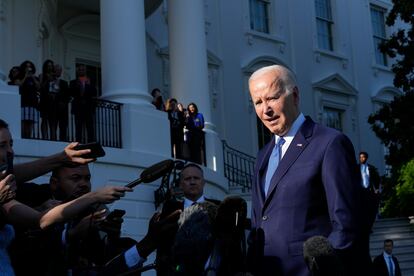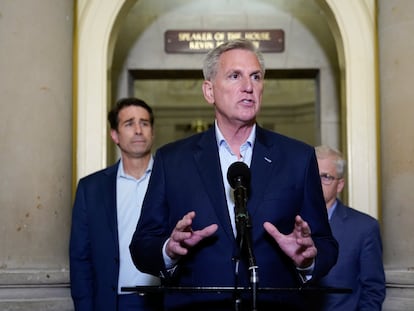Debt-ceiling deal: What’s in and what’s out of the agreement to avert US default
McCarthy said the House will vote on the legislation on Wednesday, giving the Senate time to consider it ahead of the June 5 deadline to avoid a possible default

President Joe Biden and House Speaker Kevin McCarthy have reached an agreement in principle on legislation to increase the nation’s borrowing authority and avoid a default.
Negotiators are now racing to finalize the bill’s text. McCarthy said the House will vote on the legislation on Wednesday, giving the Senate time to consider it ahead of the June 5 deadline to avoid a possible default.
While many details are unknown, both sides will be able to point to some victories. But some conservatives expressed early concerns that the deal doesn’t cut future deficits enough, while Democrats have been worried about proposed changes to work requirements in programs such as food stamps.
A look at what’s in and out of the deal, based on what’s known so far:
Two-year debt increase, spending limits
The agreement would keep non-defense spending roughly flat in the 2024 fiscal year and increase it by 1% the following year, as well as provide for a two-year debt-limit increase — past the next presidential election in 2024. That’s according to a source familiar with the deal, who provided details on the condition of anonymity.
Veterans care
The agreement will fully fund medical care for veterans at the levels included in Biden’s proposed 2024 budget blueprint, including for a fund dedicated to veterans who have been exposed to toxic substances or environmental hazards. Biden sought $20.3 billion for the toxic exposure fund in his budget.
Work requirements
Republicans had proposed boosting work requirements for able-bodied adults without dependents in certain government assistance programs. They said it would bring more people into the workforce, who would then pay taxes and help shore up key entitlement programs, namely Social Security and Medicare.
Democrats had roundly criticized the proposed changes, saying they would lead to fewer people able to afford food or health care without actually increasing job participation.
House Republicans had passed legislation that would create new work requirements for some Medicaid recipients, but that was left out of the final agreement.
However, the agreement would expand some work requirements for the Supplemental Nutrition Assistance Program, or SNAP, formerly known as food stamps. The agreement would raise the age for existing work requirements from 49 to 54, similar to the Republican proposal, but those changes would expire in 2030. And the White House said it would at the same time reduce the number of vulnerable people at all ages who are subject to the requirements
Speeding up energy projects
The deal puts in place changes in the National Environmental Policy Act that will designate “a single lead agency” to develop environmental reviews, in hopes of streamlining the process.
What was left out
Republicans had sought to repeal Biden’s efforts to waive $10,000 to $20,000 in debt for nearly all borrowers who took out student loans. But the provision was a nonstarter for Democrats. The budget agreement keeps Biden’s student loan relief in place, though the Supreme Court will have the ultimate say on the matter.
The Supreme Court is dominated 6-3 by conservatives, and those justices’ questions in oral arguments showed skepticism about the legality of Biden’s student loans plan. A decision is expected before the end of June.
Sign up for our weekly newsletter to get more English-language news coverage from EL PAÍS USA Edition
Tu suscripción se está usando en otro dispositivo
¿Quieres añadir otro usuario a tu suscripción?
Si continúas leyendo en este dispositivo, no se podrá leer en el otro.
FlechaTu suscripción se está usando en otro dispositivo y solo puedes acceder a EL PAÍS desde un dispositivo a la vez.
Si quieres compartir tu cuenta, cambia tu suscripción a la modalidad Premium, así podrás añadir otro usuario. Cada uno accederá con su propia cuenta de email, lo que os permitirá personalizar vuestra experiencia en EL PAÍS.
¿Tienes una suscripción de empresa? Accede aquí para contratar más cuentas.
En el caso de no saber quién está usando tu cuenta, te recomendamos cambiar tu contraseña aquí.
Si decides continuar compartiendo tu cuenta, este mensaje se mostrará en tu dispositivo y en el de la otra persona que está usando tu cuenta de forma indefinida, afectando a tu experiencia de lectura. Puedes consultar aquí los términos y condiciones de la suscripción digital.
More information
Archived In
Últimas noticias
Chris Martin, Taylor Swift, Elijah Wood and other famous wedding ‘crashers’
‘How does it feel to be a failure?’: Elizabeth Berkley’s journey from ‘Showgirls’ ridicule to vindication
The story of the Málaga virus: The code that haunted Google’s cybersecurity center director for 30 years
The impact of Ecuador’s mega-prison: A polluted river, cleared forests and military checkpoints
Most viewed
- Christian Louboutin: ‘Young people don’t want to be like their parents. And if their parents wear sneakers, they’re going to look for something else’
- The low-cost creative revolution: How technology is making art accessible to everyone
- Liset Menéndez de la Prida, neuroscientist: ‘It’s not normal to constantly seek pleasure; it’s important to be bored, to be calm’
- All the effects of gentrification in one corner of Mexico’s Colonia Roma
- December Social Security and SSI payments: Dates, double checks and the 2026 COLA increase










































